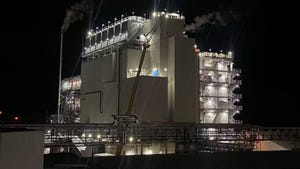Robots lead reshoring revolution
Chicago—Could robotics hold the key to a reshoring revolution in the U.S.? Reshoring has achieved buzzword status, with anecdotal tales of work returning from overseas increasingly accompanied by hard figures. Much of the focus has been on what's going on in places like China, where wages, as well as concerns about the security of intellectual property, are on the rise, but there are trends afoot in the U.S. that are driving the shift as well.
September 13, 2013
Fanuc Robotics Director Brian Rhoades points to increased adoption of automation in the U.S., especially in partnership with lean manufacturing techniques, as being a primary impetus for the U.S. reclaiming formerly offshored jobs.
"Manufacturing will go to those countries that embrace automation, use lean, and reduce production costs, while improving quality," Rhoades said. "We think North America is in the best position." Rhoades spoke at the Robotics & Animation Theater presented as part of UBM Canon's collocated advanced technologies shows at Chicago's McCormick Place (Sept. 10-12), including PLASTEC Midwest, Design & Manufacturing Midwest, ATX Midwest, Pack Zone, Quality Expo, and MD&M Chicago.
The road back
Before talking about automation's beneficial impact on the competitiveness of U.S. manufacturers, Rhoades reviewed the lean years, 2000-2010, when production fled the states en masse. In that decade, the U.S. lost 5.7 million manufacturing jobs, while China gained 11 million. In total, the U.S. and the U.K. shed almost 50% of their manufacturing base over those 10 years, resulting in only 15 million being currently employed in manufacturing.
Since 2010, however, U.S. manufacturers have added 495,000 jobs, with more to come as the baby boomer generation leaves the shopfloor for the last time. By 2020, Rhoades said it's estimated that 70 million baby boomers will retire, with only 40 million new workers entering the workforce, creating a gap of 30 million. Over that same time period, $1.36 trillion in growth of manufacturing output is forecast.
Machine loading vs. human loading: a case study
Rhoades offers a case study to show how piece-part costs can be a deceiving metric by which to judge the China cost vs. the U.S. cost. In the example offered, the machine-loaded costs for two parts came to $0.97/part in the U.S. and $0.76/part in China. When a robot was used for machine loading, the total cost shifted to $0.73/part in the U.S. versus $0.76/part in China, accounting for additional offshore costs like duties and transportation fees.
In addition to lower costs, robots also allow companies to boost efficiency. The machine utilization under manual loading of machine, in the U.S. or overseas, topped out at 82%, when you account for shift changes and breaks. Robots, of course, are always running, pushing that efficiency figure above 99%.
"Not only do you reduce the cost of the labor," Rhoades said, "but at the end of the day, you have a lot more parts."
U.S. falling behind in robotics race
Despite the benefits, however, overall utilization of robotics lags other developed industrial nations. In U.S. manufacturing, the ratio of robots to employees is 1 robot to every 86 people. In Japan, that ratio is all the way down to 1 robot for every 32 people. At Fanuc's new factory in Japan, the ratio actually flips: 10 robots to every 1 worker.
"Fanuc is faced with some of the same challenges as their customers," Rhoades said. "So they decided to really embrace automation. Reliability and quality were something that are very important to Fanuc." Now, on average company wide, Fanuc's manufacturing facilities employ eight robots to every one person.
"By automating here," Rhoades said, "we can be very competitive with overseas."
About the Author(s)
You May Also Like


